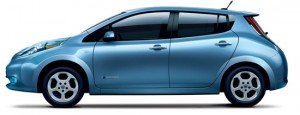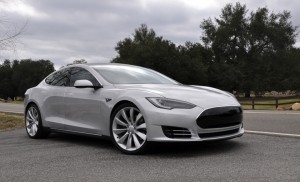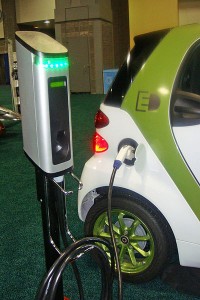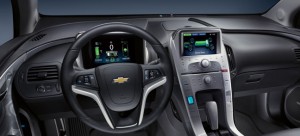Going electric on the highway
For this month's perspective post, I'm going to give readers a break from all the negative things going on in Japan, and instead tell a positive story about progress being made toward solving the world's problems. The story is about recent advances in the area of electric cars and, more specifically, my personal experiences purchasing and driving the new Chevy Volt.
Benefits of electric cars
Electric cars hold great promise with respect to reducing air pollution (especially in densely populated areas), reducing CO2 emissions, potentially reducing world oil prices, and reducing oil imports from unfriendly or unstable regions. They also are one mechanism by which nuclear power can help reduce oil imports (given that very little oil is used to generate electricity).
Unlike other options such as hydrogen, very little infrastructure investment will be required for electric cars, since the infrastructure for generating and delivering electricity is already in place. All one needs to do is plug in the car at home and charge overnight (the period of minimum electrical demand). A study by the Department of Energy's Pacific Northwest National Laboratory shows that up to 70 percent of vehicles could be electric powered before any new power plants or grid upgrades would be required, given that the vehicles are charged at off peak times.
Current hurdles
The main hurdle limiting the use of electric cars is their higher cost, which is primarily due to the cost of the battery. For pure electric (as opposed to plug-in hybrid) cars, another issue is their limited range and the current lack of options for charging the car away from home. Plug-in cars, such as the Chevy Volt, have a backup conventional engine and just switch to gasoline if the battery gets drained. The U.S. government is trying to tackle these hurdles by investing in research that will increase the battery's capacity and reduce the cost of batteries, and by giving a $7500 tax credit toward the purchase of an electric or plug-in hybrid vehicle. The tax credit will reduce the difference in price (between electric and conventional cars), which will greatly increase initial sales of electric vehicles and will result in increased production volumes, and (hopefully) will reduce costs. After a few years, many believe that the difference in cost between electric and conventional cars will be a small fraction of what it is now. At that point, reduced fuel (gasoline) costs may make up for the increased initial cost, and subsidies will no longer be necessary.
Current state of the electric car market
Unlike many other alternative transportation ideas, electric cars are actually happening. They are not merely being studied in government labs or in pilot projects. Private car companies are actually building and selling them to consumers. The number of companies planning to offer electric or plug-in models is increasing rapidly.
The response by the public (i.e., first adopters) has been enthusiastic, with demand greatly outstripping supply. For both General Motors (which sells the plug-in hybrid Volt) and Nissan (which sells the pure electric Leaf), sales are limited only by production volumes and how fast they can ramp up production, with each car being already spoken for by the time it's built. To get these cars, you have to sign up early, and the waiting lists are long.
GM plans to produce 15,000 Volts in 2011, and to raise production to as many as 60,000 in 2012. Nissan is planning to produce 150,000 Leafs in 2013. Toyota plans to release a plug-in Prius in 2012. And a newer car company, Tesla, will release its Model S sedan (about $57,000) in 2012 as well.
In addition to ramping up production of electric cars, charging stations are rapidly proliferating in many parts of the country. These stations are relatively simple devices that are showing up primarily in parking garages. Many garages offer charging for free (as part of the standard parking fee), but this may change after the initial promotional period.
The main difference between charging stations and the old gas station will not be cost or availability, but the time required to "refuel." Most charging stations are 240V, which results in charging times of 4 or 10 hours for the Volt and Leaf, respectively. Thus, you will only be able to charge at destinations that you will be staying at for awhile, such as at work or at an evening event that will last for several hours. Faster charging stations, which could charge a Volt in less than 15 minutes, are under development.
My reasons for getting a Volt
For the reasons given earlier, I decided that moving the United States toward electric transportation was an important goal. I had also heard about how first adopters have played a key role in the development of other technologies like computers and plasma TVs, etc. Prices were high at first, and only a few first adopters (the rich?) bought the products. Then, largely due to the support from first adopters, the cost of the technology dropped dramatically, putting it in the price range of most people.
I decided, for the first time, that I would act as a first adopter for this very important technology. I decided that I would buy the Volt even if it did not strictly make economic sense (i.e., even if gasoline savings did not fully offset the increased car payments). The purpose was not to save money; it was to play a role in the development of the technology.
Purchasing the car
In September 2010, after hearing that they were finally taking orders for Volts, I started looking into them. Some dealers wanted $7,500 over GM's manufacturer's suggested retail price (MSRP) of about $41,000. I responded to this by shopping around just a bit. In no time, I found another dealer who had a different philosophy, and was selling the car for MSRP.
I was told that I was no. 10 on the dealer's waiting list. The first cars showed up in December 2010. It was February 25 when my car finally showed up. It was fortunate that I looked into it as early as I did. After I reserved my car, GM started advertising the Volt, and awareness increased. This led to an avalanche of orders. The dealer told me in February that his waiting list was now up to 18 months, with new requests exceeding the rate at which he would get cars by more than a factor of 10.
I opted for the 36-month lease, which has a surprisingly low $350 monthly payment, given the car's price. In addition to the low payment, I opted for the lease because there still may be bugs to be worked out with the technology. Also, I suspect that in three years, much better plug-ins will be available, due to the steep learning curve. Finally, I don't want to have to worry about replacing the battery ($10,000?) after about 100,000 miles.
Car's features and performance
The car is a four-door sedan with a reasonably spacious back seat and room for four passengers. It is a hatchback, with a "trunk" (behind the back seats) that is a little small, but adequate. It has pretty sporty (wide, low-profile) wheels, and handles well as a result. (It doesn't have thin, low-rolling-resistance tires like the Prius.) Acceleration is also pretty good. The fact that the car is dead quiet, and has perfectly smooth acceleration (no transmission or gears), makes for a different experience.
The car has been performing pretty much as advertised. I get about 40 miles before the battery runs out of charge. When in gasoline mode, I'm getting about 40 MPG. The car has a 9-10 gallon gas tank, which results in a range of over 350 miles. My daily commute is under 20 miles, and always under 40 even with lots of errands. So, I've been traveling in pure electric mode except for the rare long-distance trip.
The car is loaded with luxury features. It has a built-in GPS system. It has a built-in Bluetooth phone system, where I can dial a number and make a call with verbal commands only. It has a built-in 30-gigabyte Ipod. The car also came with five years of GM's OnStar service and six months of XM radio. GM is offering a lot of goodies to market this car, and is treating initial Volt buyers like celebrities. We have a personal advisor who we can call at any time to ask questions or to get help. We've gotten several surveys asking for our input on the car. GM even sent us a flip video camera and a glossy hardbound book about the Volt's history, for free.
Charging the car
The Volt can be charged with any normal 120-volt outlet. A charger comes with the car. No modifications to our home were necessary. The Volt takes 10 hours to charge with a normal (120V) socket. If one puts in a special 240V charging station (which does require some electrical mods to the house), charging takes only about four hours. Pure electric cars such as the Leaf will require this kind of charging station, which costs about $2,500.
I have the charging nozzle sitting on a table next to the car's charging port (in front of the driver door). Plugging the nozzle into the port after I exit the car takes only a couple seconds, and soon becomes a matter of habit.
My local utility (Pacific Gas & Electric Company) has a special rate plan for electric car owners. The plan offers very low (about 6 cent/kW-hr) power rates at off-peak times (midnight to 7 AM). This translates into only about 2 cents per mile, as compared with about 10 cents per mile for a conventional car (based on 40 MPG and $4 gas). I can enter my utility's time-dependent rate plan into the car, and then program the car to wait until off-peak times to begin charging.
To summarize it all, I'm very happy with the car, and love the fact that I rarely use gas. I would recommend the car to anyone.
Electric car politics
In some circles, such as political websites, I have found what I consider to be a surprising amount of resistance to the government tax credits and (apparently) the idea of electric cars in general. The cars are ridiculed as being something that will never make economic sense. It is also argued that if the cars were a good idea, then tax credits should not be required.
One of the objections that I find to be at least somewhat reasonable is that the tax credits take money from the general population and give it to the small group of relatively wealthy people who will be buying the cars. Thus, a working class person will pay (tax dollars) for the tax credits, but won't benefit from them. Since the working class supposedly can't afford a Volt (even with the tax credit), they will have to go on paying for gas and then watch the richer person not have to pay for gas.
My message to the working class person would be that while you may not be able to buy an electric or plug-in car now, if you allow a tiny amount of your tax dollars go toward supporting the purchases of electric cars now by other people, affordable electric cars will be available for you down the road. At that point, you won't have to pay an arm and a leg for gas.
More generally, what these opponents can't seem to grasp is that the tax credits are a strategic investment that is in the interests of the United States. How can they not understand that a small investment in technology that would dramatically reduce our dependence on oil is a much better investment than the enormous government expenditures that go toward securing our oil supplies (i.e., patrolling the Gulf, Mideast wars, and bloated military budgets in general)?
And, these investments (tax credits) are likely to be needed for only a few years, whereas the expenditures required to secure oil supplies (read: gasoline subsidies) will likely only increase in the future. Government intervention in the "free market" on this issue is necessary because the free market does not account for all the costs associated with oil.
Initially, electric cars will not "make economic sense," versus base (non-luxury) brand/model cars of similar size. But one must ask how much sense the purchase of conventional expensive (i.e., "luxury") cars makes? I personally can't see any real, tangible benefits of any "luxury" features above and beyond those I described above for the Volt. Having a car that can go 40 miles without gasoline, and playing a part in a technological revolution that will greatly help the United States, is much more "cool" than any features that a small BMW or Lexus, etc., could possibly have.
If a person of means wants to buy a status symbol car, I would humbly suggest that an electric or plug-in car would be a far better choice. You can say that you're helping the country, and not just showing off your wealth. We need to redefine what is "cool" and what is a status symbol.

Hopf
Jim Hopf is a senior nuclear engineer at EnergySolutions, with 20 years' experience in shielding and criticality analysis and design for spent fuel dry storage and transportation systems. He has been involved in nuclear advocacy for 10 years, and is a member of the ANS Public Information Committee. He is a regular contributor to the ANS Nuclear Cafe.






